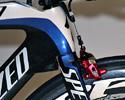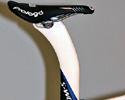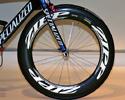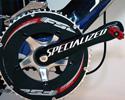
Recently on Cyclingnews.com |
Pro bikes, March 9, 2009
Fabian Cancellara's Saxo Bank Specialized S-Works Transition
Spartacus’ new speed machineBy Shane Stokes Fabian Cancellara was but a fleeting contender at this year’s Tour of California having abandoned due to fever on just the second day but nevertheless left his mark on the event, seizing the first leader’s jersey by winning the prologue time trial.
World champion in 2006 and 2007, Cancellara is widely regarded as the best time trialist in the sport and, until this year, used a Cervélo P3 to clock up a multitude of victories against the clock. However a change in bike partner for his Saxo Bank team also brings Specialized on board as a new sponsor and and he’ll now use their S-Works Transition bike Specialized intentionally made the Transition’s shape exceedingly narrow to provide as little frontal area as possible, starting first with the 1”-diameter fork steerer and narrow-yet-deep tube profiles that push the limits of the UCI technical rules. In keeping with that ‘narrower is better’ philosophy, Cancellara’s Transition features unusually tucked-in profiles for both the chain stays and seat stays. Both closely follow the outer profile of the wheel from the rim inwards before abruptly kicking out to meet the dropouts. Specialized claims this shaping ‘hides’ the stays from the wind for reduced drag. Like Cancellara’s old P3, Specialized also fits the Transition with a close-fitting seat tube that terminates in a vertical post that eliminates the need for fore/aft adjustment if the saddle height is changed. In Cancellara’s case, the seatpost head is substantially offset in order to meet UCI guidelines for setback. Other major design elements include a raised top tube that is said to smooth airflow off the back of the stem, small ‘speed gussets’ behind the well-integrated fork crown that direct air coming through the fork crown and stiffen up the head tube area – at least in the eyes of the UCI as non-structural aerodynamic aids are not allowed. In addition, the cables are internally routed and enter the frame in turbulent air behind the stem, the seatpost clamp is neatly tucked into the frame, and even the brakes have been redesigned with aerodynamics in mind. The rear brake is tucked behind the bottom bracket underneath the chain stays and both calipers use a proprietary Transition-specific design that is said to both reduce drag and increase stopping power. “The front brake is mounted on studs on the fork,” said Specialized’s Nic Sims. “A lot of the time, brakes mount through the centre of the crown, which means you get a little bit of flex in them. And especially with time trial bikes, the brake levers don’t have the power you would normally expect. So mounting a brake on studs really stiffens it, making it a really good braking setup. “The front brakes don’t stick out any further than the fork blades, so there is one profile all the way down the bike,” he continued. “At the back, the brakes are mounted down by the bottom bracket. The air down there is already dirty because of the cranks moving and stuff like that, so that is the place to put it, it is already out of the way.” In keeping with Specialized’s premium consumer models, Saxo Bank team bikes are also fitted with S-Works carbon cranks secured within an oversized shell and integrated bearings. According to Sims, the setup maximises the lateral stiffness of the bike and thus makes the most of the power going into the rear wheel. S-Works shoes and Speedplay Zero pedals complete the ensemble that channels Cancellara’s substantial power into the drivetrain, which itself is made up mainly of Shimano Dura-Ace parts. Cancellara’s bike was finished off with a variety of other parts, including a Prologo saddle, , a rear Zipp disk and front Zipp 808 deep-section carbon wheel, Specialized-branded tyres – likely made by someone else as they bear neither the slick tread or dual radius of the consumer version – and a Tacx bottle cage. FSA provides much of the front end, which includes a Vision semi-integrated carbon aero bar with S-bend extensions and narrowly spaced pads, Vision aluminum brake levers, and a Vision stem. Cancellara will have another shot at victory coming up at Tirreno-Adriatico from March 11 to 17. A recent shoulder injury sustained while riding at home in Switzerland puts his form in question but we still anticipate that the big Swiss rider will still have plenty of power to spare. PhotographyFor a thumbnail gallery of these images, click here Images by Shane Stokes/Cyclingnews.com
| |||||
Full specificationFrame: Specialized S-Works Transition, size L Critical measurements Front brake: S-Works integrated |
Front wheel: Zipp 808 tubular Bars: Vision by FSA Trimax SI with R-bend extensions, 41cm (c-c) Pedals: Speedplay Zero chromoly | ||||






